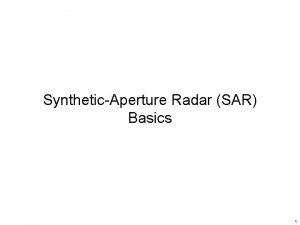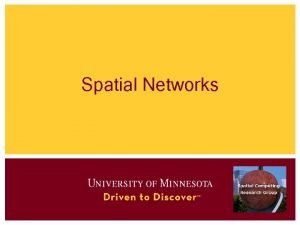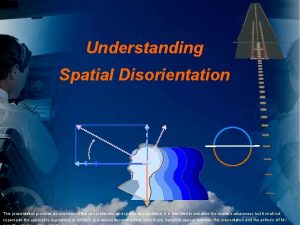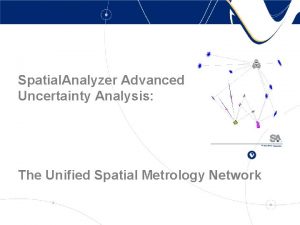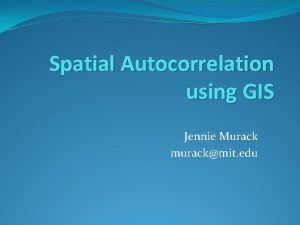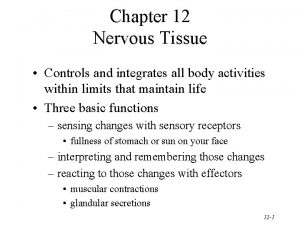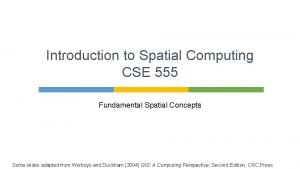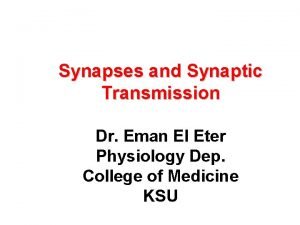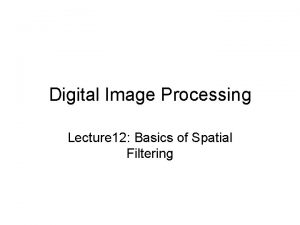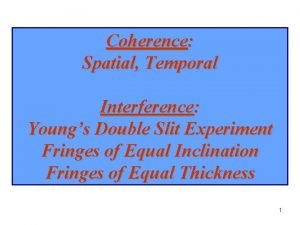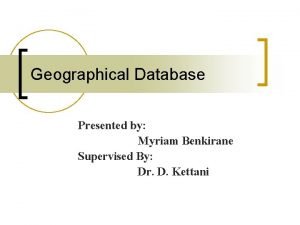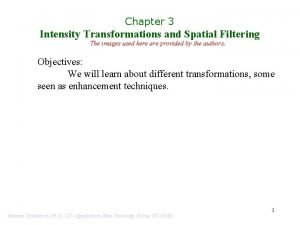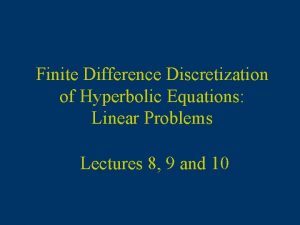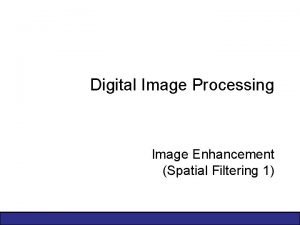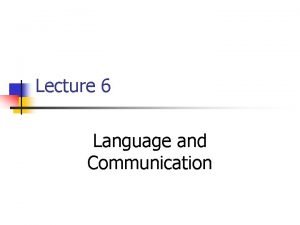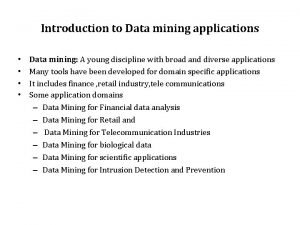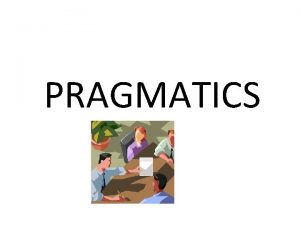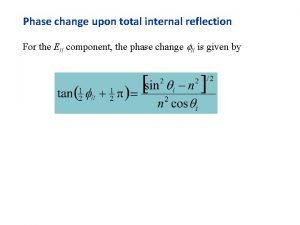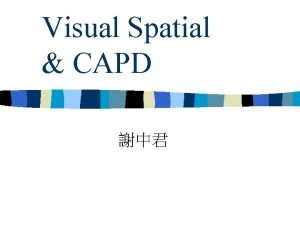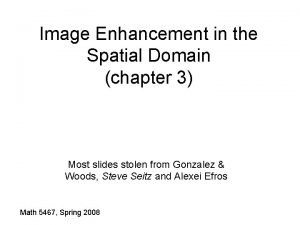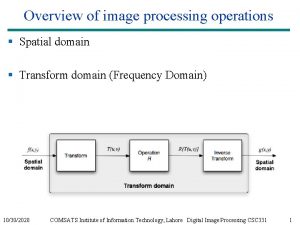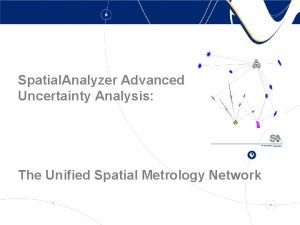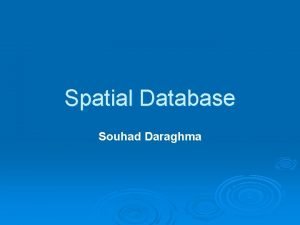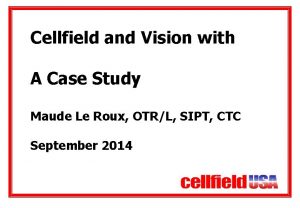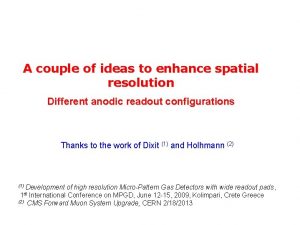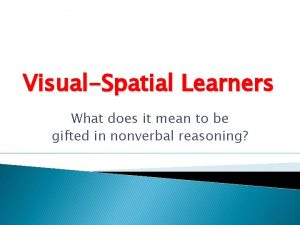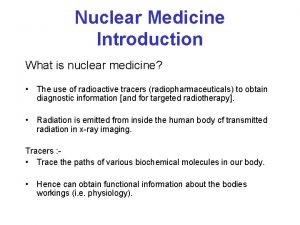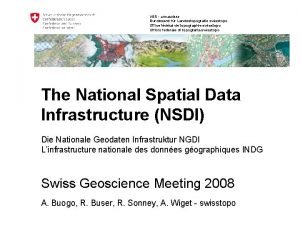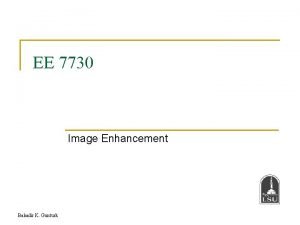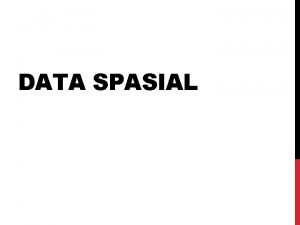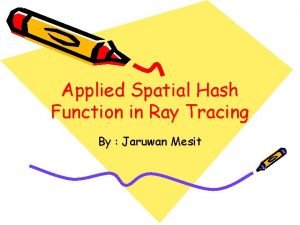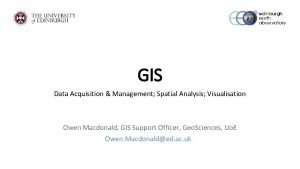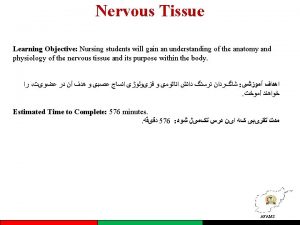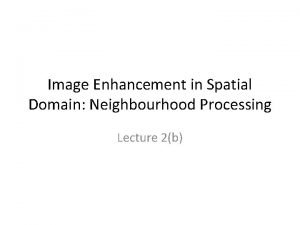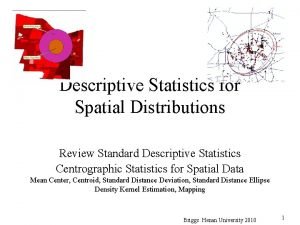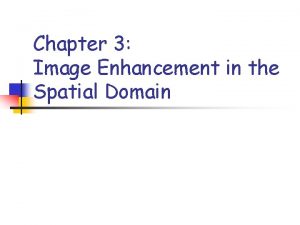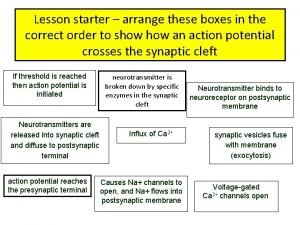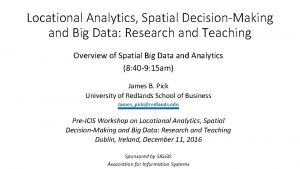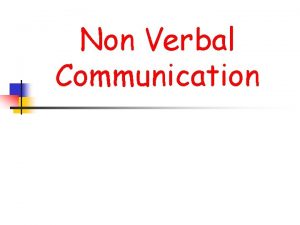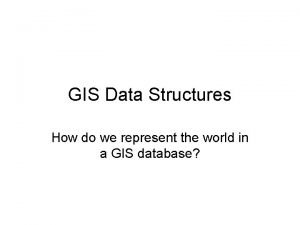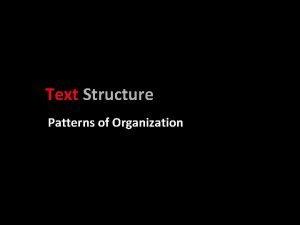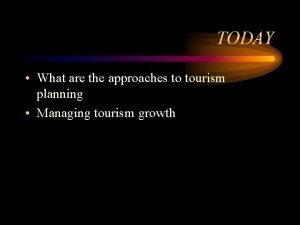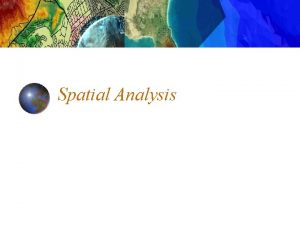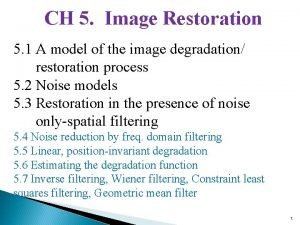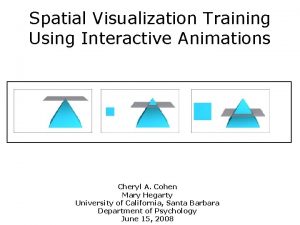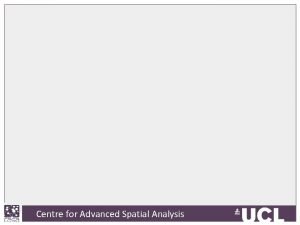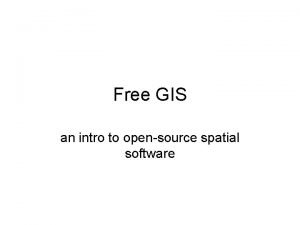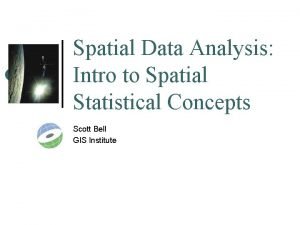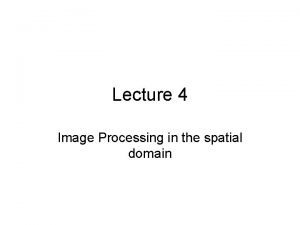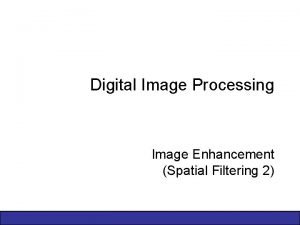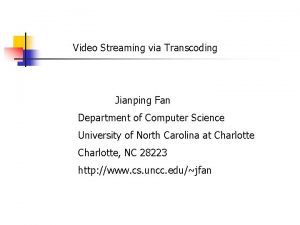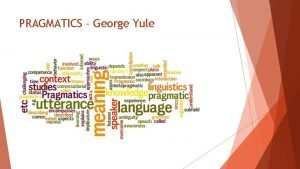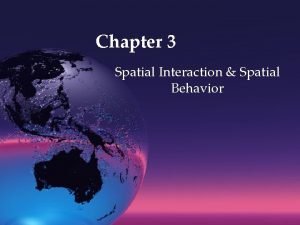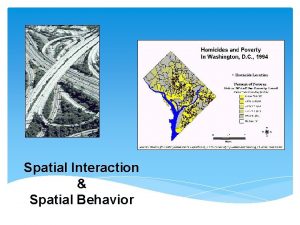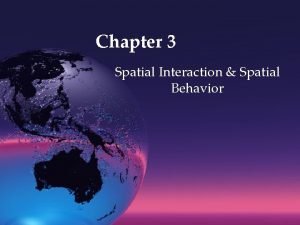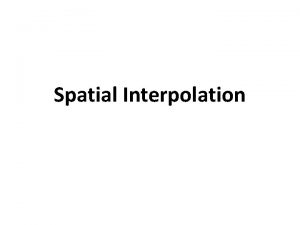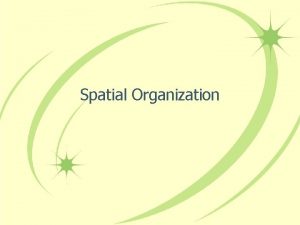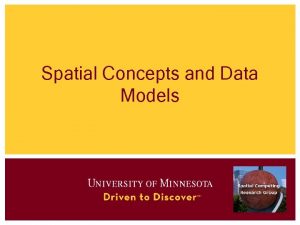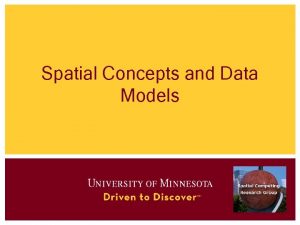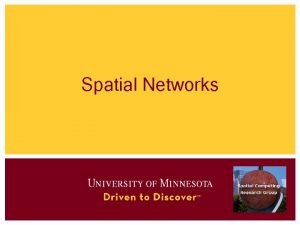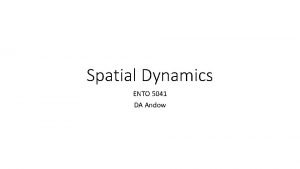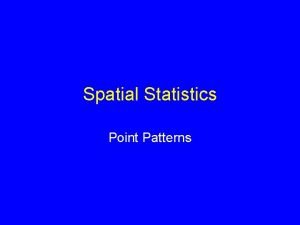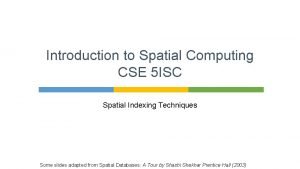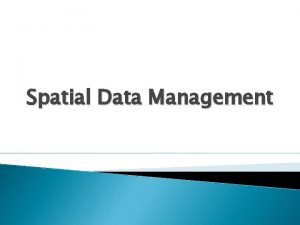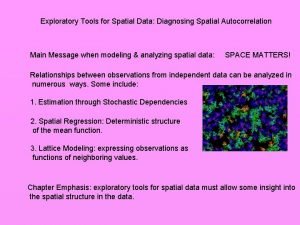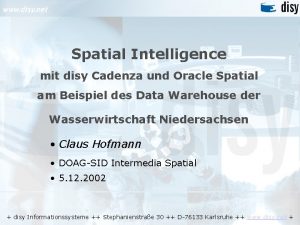Spatial Networks Outline 1 2 3 4 5





















![Main Memory Data-Structures • Adjacency matrix • • M[A, B] = 1 if and Main Memory Data-Structures • Adjacency matrix • • M[A, B] = 1 if and](https://slidetodoc.com/presentation_image_h/24ac6ff17eb21298040c370eda109150/image-22.jpg)






















































- Slides: 76

Spatial Networks

Outline 1. 2. 3. 4. 5. 6. 7. 8. 9. Motivation, and use cases Example spatial networks Conceptual model Need for SQL extensions CONNECT statement RECURSIVE statement Storage and data structures Algorithms for connectivity query Algorithms for shortest path

Navigation Systems • Historical • • Navigation is a core human activity for ages! Trade-routes, Routes for Armed-Forces • Recent Consumer Platforms • • Devices: Phone Apps, In-vehicle, “GPS”, … WWW: Google Maps, Map. Quest, … • Services • • • Display map around current location Compute the shortest route to a destination Help drivers follow selected route

Location Based Services • Location: Where am I ? – Geo-code: Place Name (or Street Address) <latitude, longitude> – Reverse Geo-code: <latitude, longitude> Place Name • Directory: What is around me? – Where is the nearest Clinic? Restaurant? Taxi? – List all Banks within 1 mile. • Routes: How do I get there? – What is the shortest path to get there? – …

Spatial Networks & Modern Society • Transportation, Energy, Water, Communications, …

Limitations of Spatial Querying • OGIS Simple Feature Types • Supports Geometry (e. g. , Points, Line. Strings, Polygons, …) • However, lack Graphs data type, shortest_path operator • Traditional SQL • Supports select, project, join, statistics • Lacked transitive closure, e. g. , network analysis (next slide) • SQL 3 added recursion & transitive closure

Spatial Network Analysis • Route ( A start-point, Destination(s) ) – What is the shortest path to get there? – What is the shortest path to cover a set of destinations? • Allocation ( A set of service centers, A set of customers) – Assign customers to nearest service centers – Map service area for each service center • Site Selection ( A set of customers, Number of new service centers) – What are best locations for new service centers ?

Outline 1. 2. 3. 4. 5. 6. 7. 8. 9. Motivation, and use cases Example spatial networks Conceptual model Need for SQL extensions CONNECT statement RECURSIVE statement Storage and data structures Algorithms for connectivity query Algorithms for shortest path

Spatial Network Query Example 1. 2. 3. 4. Find shortest path from a start-point to a destination Find nearest hospital by driving distance Find shortest route to deliver packages to a set of homes Allocate customers to nearest service center

Railway Network & Queries 1. 2. 3. 4. Find the number of stops on the Yellow West (YW) route. List all stops which can be reached from Downtown Berkeley (2) List the routes numbers that connect Downtown Berkeley (2) & Daly City (5) Find the last stop on the Blue West (BW) route

River Network & Queries 1. List the names of all direct and indirect tributaries of Mississippi river 2. List the direct tributaries of Colorado 3. Which rivers could be affected if there is a spill in North Platte river

Spatial Networks: Three Examples A Road Network A River Network A Railway Network

Outline 1. 2. 3. 4. 5. 6. 7. 8. 9. Motivation, and use cases Example spatial networks Conceptual model Need for SQL extensions CONNECT statement RECURSIVE statement Storage and data structures Algorithms for connectivity query Algorithms for shortest path

Data Models of Spatial Networks 1. Conceptual Model • • Information Model: Entity Relationship Diagrams Mathematical Model: Graphs 2. Logical Data Model • • Abstract Data types Custom Statements in SQL 3. Physical Data Model • • Storage-Structures Algorithms for common operations

Modeling Roadmaps Many Concepts, e. g. • • • Roads (or streets, avenues) Road-Intersections Road-Segments Turns …

An Entity Relationship Diagram

Graph Models • A Simple Mathematical Model • • A graph G = (V, E) V = a finite set of vertices E = a set of edges model a binary relationship between vertices Example

A Graph Model of River Network • Nodes = rivers • Edges = A river falls into another river

Alternative Graph Models for Roadmaps • Choice 1 (most popular): • Nodes = road-intersections • Edge (A, B) = road-segment connects adjacent road-intersections A, B • Choice 2: • Nodes = (directed) road-segments • Edge (A, B) = turn from road-segment A to road-segment B • Choice 3: • Nodes = roads • Edge(A, B) = road A intersects_with road B

Spatial Network vs Traditional Graphs • Nodes and edges have spatial features • Spatial indexes are used in a lot of applications – Moving objects apps – Emergency response – …etc

Data Models of Spatial Networks 1. Conceptual Model : Entity Relationship Diagrams, Graphs 2. Logical Data Model : Abstract Data types , Custom Statements in SQL 3. Physical Data Model • • Storage: Data-Structures, File-Structures Algorithms for common operations
![Main Memory DataStructures Adjacency matrix MA B 1 if and Main Memory Data-Structures • Adjacency matrix • • M[A, B] = 1 if and](https://slidetodoc.com/presentation_image_h/24ac6ff17eb21298040c370eda109150/image-22.jpg)
Main Memory Data-Structures • Adjacency matrix • • M[A, B] = 1 if and only if edge(vertex A, vertex B) exists Adjacency list : • maps a vertex to a list of its successors

Disk-based Tables • Normalized tables • • one for vertices, other for edges Denormalized • one table for nodes with adjacency lists

File-Structures: Partition Graph into Disk Blocks • Which partitioning reduces disk I/O for graph operations? • • Choice 1: Geometric partition Choice 2: min-cut Graph Partition Choice 2 cuts fewer edges and is preferred Assuming uniform querying popularity across edges

Graph Based Storage Methods • Consider two disk-paging of Minneapolis major roads • Non-white edges => node pair in same page • White edge are cut-edges • Node partitions on right has fewer cut-edges and is preferred

Exercise: Graph Based Storage Methods • Consider spatial network on right • If a disk page holds 3 records, which partitioning will have fewest cut-edges? (a) (1, 2, 3), (4, 5, 6) (b) (2, 3, 4), (1, 5, 6) (c) (1, 2, 6), (3, 4, 5)

Outline 1. 2. 3. 4. 5. 6. 7. 8. 9. Motivation, and use cases Example spatial networks Conceptual model Need for SQL extensions CONNECT statement RECURSIVE statement Storage and data structures Algorithms for connectivity query Algorithms for shortest path

Data Models of Spatial Networks 1. Conceptual Model : Entity Relationship Diagrams, Graphs 2. Logical Data Model : Abstract Data types , Custom Statements in SQL 3. Physical Data Model • • Storage-Structures Algorithms for common operations

Query Processing for Spatial Networks • Query Processing • • • DBMS decomposes a query into building blocks Keeps a couple of strategy for each building block Selects most suitable one for a given situation • Building blocks • Connectivity(A, B): Is node B reachable from node A? • Shortest path(A, B): Identify least cost path from node A to node B

Algorithms • Main memory • • • Connectivity: Breadth first search, depth first search Shortest path: Dijkstra’s algorithm, A* Disk-based • • Shortest path - Hierarchical routing algorithm Connectivity strategies are in SQL 3

Algorithms for Connectivity Query • Breadth first search • Visit descendent by generation • Children before grandchildren • Example: 1 - (2, 4) - (3, 5) • Depth first search • Try a path till dead-end • Backtrack to try different paths • Like a maze game • Example: 1 -2 -3 -2 -4 -5 • Note backtrack from 3 to 2 5 3

Outline 1. 2. 3. 4. 5. 6. 7. 8. 9. Motivation, and use cases Example spatial networks Conceptual model Need for SQL extensions CONNECT statement RECURSIVE statement Storage and data structures Algorithms for connectivity query Algorithms for shortest path

Shortest Path Algorithms • Iterate • Expand most promising descent node • Dijkstra’s: try closest descendant to self • A* : try closest descendent to both destination and self • Update current best path to each node, if a better path is found • Till destination node is expanded

Dijkstra’s vs. A* Dijkstra’s Algorithm A* Algorithm

Dijkstra’s vs. A* Dijkstra’s Algorithm A* Algorithm

Dijkstra’s vs. A* Dijkstra’s Algorithm A* Algorithm

Dijkstra’s vs. A* Dijkstra’s Algorithm A* Algorithm

Dijkstra’s vs. A* Dijkstra’s Algorithm A* Algorithm

Dijkstra’s vs. A* Arrived! Dijkstra’s Algorithm A* Algorithm

Dijkstra’s vs. A* Dijkstra’s Algorithm

Dijkstra’s vs. A* Dijkstra’s Algorithm

Dijkstra’s vs. A* Arrived! Dijkstra’s Algorithm

Shortest Path Algorithms • Iterate • Expand most promising node • Dijkstra’s: try closest descendent to self • A* : try closest descendent to both destination and self • Update current best path to each node, if a better path is found • Till destination node is expanded • Correct assuming • • • Sub-path optimality Fixed, positive and additive edge costs A* : underestimate function (i. e. admissible)

Shortest Path Strategies - 3 • Dijkstra’s and Best first algorithms • Work well when entire graph is loaded in main memory • Otherwise their performance degrades substantially • Hierarchical Routing Algorithms • Works with graphs on secondary storage • Loads small pieces of the graph in main memories • Can compute least cost routes

Shortest Path Strategies - 3 (Key Ideas) • Key ideas behind Hierarchical Routing Algorithm • Fragment graphs - pieces of original graph obtained via node partitioning • Boundary nodes - nodes of with edges to two fragments • Boundary graph - a summary of original graph • Contains Boundary nodes • Boundary edges: edges across fragments or paths within a fragment

Shortest Path Strategies – 3 (Insight) • A Summary of Optimal path in original graph can be computed • Using Boundary graph and 2 fragments • The summary can be expanded into optimal path in original graph • Examining fragments overlapping with the path • Loading one fragment in memory at a time

END OF REQUIRED CONTENT

Outline 1. 2. 3. 4. 5. 6. 7. 8. 9. Motivation, and use cases Example spatial networks Conceptual model Need for SQL extensions CONNECT statement RECURSIVE statement Storage and data structures Algorithms for connectivity query Algorithms for shortest path

Data Models of Spatial Networks 1. Conceptual Model: Entity Relationship Diagrams, Graphs 2. Logical Data Model & Query Languages • • Abstract Data types Custom Statements in SQL 3. Physical Data Model: Storage-Structures, Algorithms

Transitive Closure • Consider a graph G = (V, E) • Transitive closure (G) is: G* = (V*, E*), where • V* = V • (A, B) in E* if and only if there is a path from A to B in G.

Transitive Closure - Example • G has 5 nodes and 5 edges • G* has 5 nodes and 9 edges • Note edge (1, 4) in G* for • path (1, 2, 3, 4) in G.

Limitations of Original SQL • Recall Relation algebra based languages • Ex. Original SQL • Can not compute transitive closure, e. g. , shortest path

Supporting Graphs in SQL • Abstract Data Type (user defined) • SQL 3 • May include shortest path operation! • Custom Statements • SQL 2 - CONNECT clause in SELECT statement • For directed acyclic graphs, e. g. hierarchies • SQL 3 - WITH RECURSIVE statement • Transitive closure on general graphs

Outline 1. 2. 3. 4. 5. 6. 7. 8. 9. Motivation, and use cases Example spatial networks Conceptual model Need for SQL extensions CONNECT statement RECURSIVE statement Storage and data structures Algorithms for connectivity query Algorithms for shortest path

Querying Graphs: Overview • Relational Algebra • Can not express transitive closure queries • Two ways to extend SQL to support graphs 1. Abstract Data Types 2. Custom Statements – – SQL 2 - CONNECT BY clause(s) in SELECT statement SQL 3 - WITH RECURSIVE statement

CONNECT BY : Input, Output • Input: (a) Edges of a directed acyclic graph G • • (b) Start Node S, e. g. , Missouri (c) Travel Direction • Output: Part of transitive closure of G • • Ex. Predecessors of “S = Missouri” Ex. Successors of “S = Missouri”

Directed Edges: Tabular Representation Table: Falls_Into Source Dest P 1 Platte P 2 Platte Y 1 Yellowstone Y 2 Yellowstone Platte Missouri Yellowstone Missouri Mississippi Ohio Mississippi Red Mississippi Arkansas Mississippi

CONNECT BY– PRIOR - START WITH SELECT source FROM Falls_Into CONNECT BY PRIOR source = dest START WITH dest =“Missouri” Q? What does CONNECT BY … PRIOR specify? • Direction of travel • Example: From Dest to Source • Alternative: From Source to Dest Table: Falls_Into Source Dest P 1 Platte P 2 Platte Y 1 Yellowstone Y 2 Yellowstone Platte Missouri Yellowstone Missouri Mississippi Ohio Mississippi Red Mississippi Arkansas Mississippi

CONNECT BY– PRIOR - START WITH Table: Falls_Into Choice 1: Travel from Dest to Source Ex. List direct & indirect tributaries of Missouri. SELECT source FROM Falls_Into CONNECT BY PRIOR source = dest START WITH dest =“Missouri” Choice 2: Travel from Source to Dest Ex. Which rivers are affected by spill in Missouri? SELECT dest FROM Falls_Into CONNECT BY source = PRIOR dest START WITH source =“Missouri” Source Dest P 1 Platte P 2 Platte Y 1 Yellowstone Y 2 Yellowstone Platte Missouri Yellowstone Missouri Mississippi Ohio Mississippi Red Mississippi Arkansas Mississippi

Execution Trace – Step 1 SELECT source FROM Falls_Into CONNECT BY PRIOR source = dest START WITH “dest = Missouri” Table: Falls_Into Source Dest P 1 Platte P 2 Platte Y 1 Yellowstone Table: “Prior ” Y 2 Yellowstone Source Dest Platte Missouri Yellowstone Missouri Mississippi Ohio Mississippi Red Mississippi Arkansas Mississippi 1. Prior Result = SELECT * FROM Falls_Into WHERE dest = “Missouri” Yellowstone Missouri

Execution Trace – Step 2. SELECT source FROM Falls_Into CONNECT BY PRIOR source = dest START WITH dest = Missouri Table: Falls_Into Source Dest P 1 Platte 2. Iteratively add Records(Prior_Result. source = Falls_Into. dest) P 2 Platte Prior Result Source Dest P 1 Platte P 2 Platte Prior Result Y 1 Yellowstone Source Dest Y 2 Yellowstone Platte Missouri Yellowstone Missouri Y 1 Yellowstone Y 2 Yellowstone Platte Missouri Yellowstone Missouri Mississippi Ohio Mississippi Red Mississippi Arkansas Mississippi

Outline 1. 2. 3. 4. 5. 6. 7. 8. 9. Motivation, and use cases Example spatial networks Conceptual model Need for SQL extensions CONNECT statement RECURSIVE statement Storage and data structures Algorithms for connectivity query Algorithms for shortest path

Learning Objectives • After this segment, students will be able to • Describe RECURSIVE statement in SQL 3 • Use it to query Graphs

Querying Graphs: Overview • Relational Algebra • Can not express transitive closure queries • Two ways to extend SQL to support graphs 1. Abstract Data Types 2. Custom Statements – – SQL 2 - CONNECT clause(s) in SELECT statement SQL 3 - WITH RECURSIVE statement

WITH RECURSIVE: Input, Output • Input: • (a) Edges of a directed graph G • (b) Sub-queries to – – – Initialize results Recursively grow results Additional constraints • Output: Transitive closure of G • • Ex. Predecessors of a node Ex. Successors of a node

Syntax of WITH RECURSIVE Statement WITH RECURSIVE X(source, dest) AS (SELECT source, dest FROM R ) UNION (SELECT R. source, X. dest FROM R, X WHERE R. dest=X. source ) Description of Result Table Initialization Query Recursive Query to grow result

Example Input and Output WITH RECURSIVE X(source, dest) AS (SELECT source, dest FROM R ) UNION (SELECT R. source, X. dest FROM R, X WHERE R. dest=X. source )

SQL 3 Recursion Example - Meaning • Initialize X by (SELECT source, dest FROM R ) • Recursively grow X by (SELECT R. source, X. dest FROM R, X WHERE R. dest=X. source ) • Infer X(a, c) from R(a, b), X(b, c) • • Infer X(1, 3) from R(1, 2), X(2, 3) Infer X(2, 4) from R(2, 3), X(3, 4) Infer X(5, 4) from R(5, 3), X(3, 4) Infer X(1, 4) from R(1, 5), X(5, 4)

Quiz Which of the following are true about WITH RECURSIVE clause? a) It is able to output transitive closure of a directed graph b) It usually works with an edge table c) It includes two SELECT statements d) All of the above

Outline 1. 2. 3. 4. 5. 6. 7. 8. 9. Where do we use spatial networks? Example spatial networks Conceptual model of spatial networks Why do we need SQL extensions CONNECT clause RECURSIVE statement Data structures Algorithms for connectivity query Algorithms for shortest path

Hierarchical Routing Algorithm-Step 1 • Step 1: Choose Boundary Node Pair • Minimize COST(S, Ba)+COST(Ba, Bd)+COST(Bd, D) • Determining Cost May Be Non-Trivial Fig 6. 7(a)

Hierarchical Routing- Step 2 • Step 2: Examine Alternative Boundary Paths • Between Chosen Pair (Ba, Bd) of boundary nodes Fig 6. 7(b)

Hierarchical Routing- Step 2 Result • Step 2 Result: Shortest Boundary Path Fig 6. 8(a)

Hierarchical Routing- Step 3 • Step 3: Expand Boundary Path: (Ba 1, Bd) -> Ba 1 Bda 2 Ba 3 Bda 4…Bd • Boundary Edge (Bij, Bj) ->fragment path (Bi 1, N 1 N 2 N 3……. Nk, Bj) Fig 6. 8(a)

Quiz Which of the following is false? a) Hierarchical routing algorithms are Disk-based shortest path algorithms b) Breadth first search and depth first search are both connectivity query algorithms c) Best first algorithm is always faster than Dijkstra’s algorithm d) None of the above

Summary • Spatial Networks are a fast growing applications of SDBs • Spatial Networks are modeled as graphs • Graph queries, like shortest path, are transitive closure • • not supported in relational algebra SQL features for transitive closure: CONNECT BY, WITH RECURSIVE • Graph Query Processing • • Building blocks - connectivity, shortest paths Strategies - Best first, Dijkstra’s and Hierarchical routing • Storage and access methods • Minimize CRR
 Oflinemaps
Oflinemaps Chen-hsuan lin
Chen-hsuan lin Spatial transformer networks github
Spatial transformer networks github Diffraction plate
Diffraction plate Spatial outline
Spatial outline Virtual circuits and datagram networks
Virtual circuits and datagram networks Basestore iptv
Basestore iptv Examples of quote sandwiches
Examples of quote sandwiches False climb illusion
False climb illusion Text structure spatial
Text structure spatial Usmn
Usmn Spatial autocorrelation
Spatial autocorrelation Intensity transformations and spatial filtering
Intensity transformations and spatial filtering Spatial summation
Spatial summation Spatial computing
Spatial computing Order of importance text structure
Order of importance text structure Temporal summation example
Temporal summation example Spatial filtering
Spatial filtering What is temporal and spatial coherence
What is temporal and spatial coherence Spatial database
Spatial database Intensity transformation and spatial filtering
Intensity transformation and spatial filtering Lax equivalence theorem
Lax equivalence theorem Descriptive sentence
Descriptive sentence Spatial resolution in digital image processing
Spatial resolution in digital image processing Spatial filtering in digital image processing
Spatial filtering in digital image processing Spatial communication
Spatial communication Difference between linear and nonlinear spatial filters
Difference between linear and nonlinear spatial filters Spatial interaction ap human geography
Spatial interaction ap human geography Spatial data mining applications
Spatial data mining applications Spatial deixis
Spatial deixis Temporal and spatial coherence
Temporal and spatial coherence Visual spatial relations
Visual spatial relations What is enhancement in the spatial domain?
What is enhancement in the spatial domain? Spatial operations in image processing
Spatial operations in image processing Spatial analyzer software
Spatial analyzer software Spatial design network analysis
Spatial design network analysis Abbe imaging experiment
Abbe imaging experiment Spatial database meaning
Spatial database meaning Visual spatial relations
Visual spatial relations Spatial resolution
Spatial resolution Upside-down brilliance: the visual-spatial learner
Upside-down brilliance: the visual-spatial learner Lifestyle medicine
Lifestyle medicine Swiss vbs
Swiss vbs Spatial filtering
Spatial filtering Gambar data spasial
Gambar data spasial Spatial hash
Spatial hash Gis
Gis V node
V node Image enhancement in spatial domain
Image enhancement in spatial domain Descriptive/spatial
Descriptive/spatial Combining spatial enhancement methods
Combining spatial enhancement methods Temporal vs spatial summation
Temporal vs spatial summation Spatial big data platform
Spatial big data platform Information transfer verbal to non verbal pie chart
Information transfer verbal to non verbal pie chart What is data structure in gis
What is data structure in gis Text structure spatial
Text structure spatial What is human geography
What is human geography Community oriented approach in tourism planning
Community oriented approach in tourism planning Spatial vis
Spatial vis Domain spasial adalah
Domain spasial adalah Spatial analysis questions
Spatial analysis questions Restoration in the presence of noise only-spatial filtering
Restoration in the presence of noise only-spatial filtering Signing naturally if only i could fly
Signing naturally if only i could fly Spatial turn cos'è
Spatial turn cos'è Spatial visualization training
Spatial visualization training Ct wimage
Ct wimage V number in optical fiber
V number in optical fiber Paragraph describing a place
Paragraph describing a place Centre for advanced spatial analysis
Centre for advanced spatial analysis Spatial dbms
Spatial dbms Spatial
Spatial What is spatial data?
What is spatial data? Spatial domain
Spatial domain Combining spatial enhancement methods
Combining spatial enhancement methods Spatial resolution
Spatial resolution Sid and spatial resolution
Sid and spatial resolution Discourse deixis examples
Discourse deixis examples



